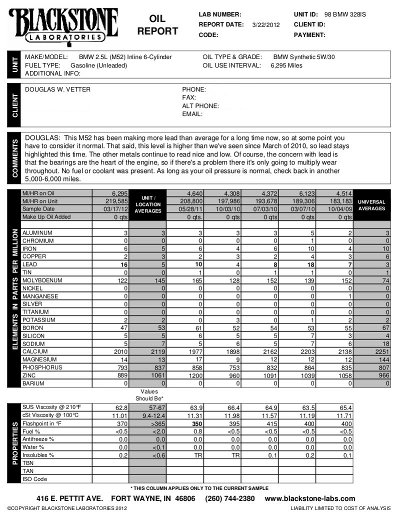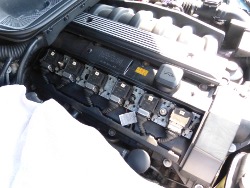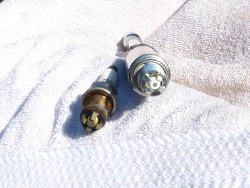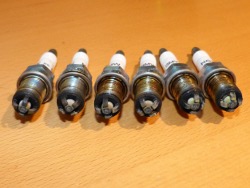Saturday, March 17, 2012
Early Spring Service Part 2
With temperatures in the 60's and sunny skies, today seemed like a good day to finish up my early spring service by doing an oil service with oil analysis and spark plug replacement. I got both jobs done in less than two hours and both went about as smoothly as one could expect. Dare I say it, but this is old hat at this point.
Although I am concerned that the extra time on the oil will naturally inflate the oil analysis numbers, I skipped the analysis last fall and do need to keep an eye on the progression of the lead wear issue. The last thing I need is to start grinding away at a bearing and have a rod blow through the block. I really would like to overhaul my own engine rather than be forced to rely on an unknown core when the time comes, so that means some due diligence on my part. I plan to send the analysis out this week.
When it came time to do the plug service, I instinctually removed the covers for the nuts that secure the fuel rail cover (that's why they're removed in the picture) but I quickly speculated that I could remove the engine head cover without pulling the fuel rail cover despite the fact that they overlap a bit, particularly in one location near the front, and that turned out to be the case. That saved me all of a minute of work but life is short, so faster is better.
After I removed the coils I brought the compressor up to pressure and blew out the plug holes. As expected they were perfectly clean and dry to start with but it never hurts to play it safe. The old plugs loosened with a lot less drama than they did last time. This may be because my technician tightened the prior set a bit more than I do but I can't know that for sure. BMW's spec is 22 ft*lbs (dry fit, no anti-seize), so that's what I used to tighten the new plugs before buttoning everything up and turning the key to test my work. The engine fired on the first cylinder and settled into a very smooth idle. Pickup below 4000 RPM seemed to be a bit better too, but it is probably just in my head. Spending $100+ on new plugs will tend to do that.
 Incidentally, plugs are a good indicator
of the state of the engine if you know what to look for. Generally speaking,
plugs should be dry with a slight white tinge to the normal and expected light
carbon deposits on and around the electrodes. One big red flag is wetness that
does not evaporate, which indicates oil control ring wear; something
that must be monitored on an engine this old. Another red flag is heavy black
carbon fouling or very white and heat-damaged electrodes, which usually means
mixture control problems. However, while I might expect to see this kind of
fouling on an old carbureted engine or perhaps an engine with forced induction
and a custom tune, it is highly unlikely to occur on a stock BMW engine for
the simple reason that the DME can detect misfires and cut off fuel to the
affected cylinder(s), as well as tightly control the mixture by monitoring
the oxygen sensors in real time.
Incidentally, plugs are a good indicator
of the state of the engine if you know what to look for. Generally speaking,
plugs should be dry with a slight white tinge to the normal and expected light
carbon deposits on and around the electrodes. One big red flag is wetness that
does not evaporate, which indicates oil control ring wear; something
that must be monitored on an engine this old. Another red flag is heavy black
carbon fouling or very white and heat-damaged electrodes, which usually means
mixture control problems. However, while I might expect to see this kind of
fouling on an old carbureted engine or perhaps an engine with forced induction
and a custom tune, it is highly unlikely to occur on a stock BMW engine for
the simple reason that the DME can detect misfires and cut off fuel to the
affected cylinder(s), as well as tightly control the mixture by monitoring
the oxygen sensors in real time.
I found the plugs in good shape across the board, which tells me that all the cylinders are wearing consistently with good oil control. These plugs had more mileage on them than the set I replaced in 2007 and yet appeared to have held up better. Based on their appearance I would normally extend the replacement interval to 80K or more but as I've said before there are other things to be concerned about here, including valve cover gasket leaks and overall engine health. Thus it is always better to get your eyeballs "inside" the engine more frequently so my plug change interval will remain at 72K miles or roughly half the expected lifespan of the valve cover gaskets.
Now the fun part. When I combine the labor savings from Part 1 with the 2.0 hours of labor required for the oil service and plug replacement in Part 2, I'm looking at a total labor savings of $421. The parts savings of $50, while not as impressive, brings the total DIY dividend of this project to $471. My out of pocket cost again? $211. Total time out of my life? Three hours. DIY: It's like vitamins for your wallet™. :)
Next up: swapping my winter wheels and tires for my summer set.
Update 3/22/2012: I received the oil analysis today and the results were predictable. Lead is up again, but I think most of the increase can be attributed to the longer oil change interval and the possibility that oil changes in March skew the numbers due to all the cold winter starts which are known to be bad for engine wear in general and bearings in specific. In any case, I doubt 16PPM is anything to be concerned about right now but that will change, of course, if lead spikes from this "new norm". Next oil service will likely be in mid-summer.
Mileage: 219585, Labor Saved: $256, Labor: $25






